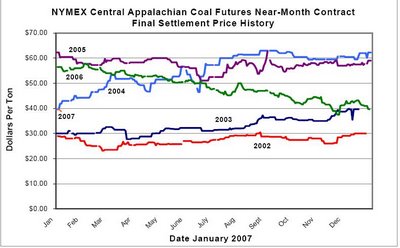
Yesterday, I wrote an article about the effect of the price of oil on certain utility stocks. Today, I am writing about how coal can have a similar effect on a much larger group of utilities.
As you can see from the chart courtesy of the Energy Information Administration division of the U. S. Department of Energy, the NYMEX price of Central Appalachian Coal Futures is the lowest it's been in the last three years. You will notice that the tiny orange line on the left next to the $40 and trending downward, is lower than the blue 2004 line, the purple 2005 line, and the green 2006 line [with the exception of a short period in November].
As of the end of last week, the price per ton was $38.75, far below its high of $63 back in August and Septmber of 2004.
So what does this mean for utility stocks? Since more than half of all utilities use coal for electrical generation, the fuel cost reduction can cause a major savings in expenses for the companies. The following is a list of electrical utilities which use coal as a fuel to generate at least 40% of their electricity [the ones with very high coal generated electricity have been noted].
Ameren Corporation (AEE) [over 85%]
ALLETE Inc. (ALE)
Allegheny Energy Inc. (AYE) [over 75%]
CMS Energy Corp. (CMS)
DPL Inc. (DPL)
DTE Energy Co. (DTE) [over 70%]
Duke Energy Corp. (DUK)
Firstenergy Corp. (FE)
Great Plains Energy Inc. (GXP) [over 70%]
Aquila Inc. (ILA)
MDU Resources Group Inc. (MDU) [over 70%]
MGE Energy Inc. (MGEE)
Nisource Inc. (NI) [over 85%]
OGE Energy Corp. (OGE)
Otter Tail Corp. (OTTR)
PNM Resources Inc. (PNM) [over 70%]
SCANA Corp. (SCG)
Southern Co. (SO)
TECO Energy Inc. (TE)
Unisource Energy Corp. (UNS)
Wisconsin Energy Corp. (WEC)
WPS Resources Corp. (WPS)
Westar Energy Inc. (WR) [over 75%]
Xcel Energy Inc. (XEL)
1 comment:
Depending on the utilities and the contracts they've signed, and considering that the downward trend has continued for over a year, the utilities should see a reduction in the next six months to a year and a half.
Post a Comment